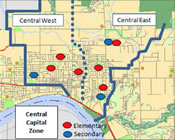The Central Capital Zone consists of six elementary schools and two secondary schools and will be reviewed in two individual zones – the Central West Zone and the Central East Zone.
Each separate zone has 3 elementary schools and 1 secondary school.
Enrolment Projections Central Capital Zone
In the Central Zone, the historical and forecasted enrolment is shown relative to the available functional capacity of the schools in this zone. By 2023 the schools in this zone are expected to be fully utilized.

Elementary Schools Central Capital Zone
In the Central West Zone, the historical and forecasted enrolment is shown relative to the available functional capacity. By 2023 the elementary schools in this zone are expected to be fully utilized.

In the Central West Zone, the current and forecasted relationship between capacity and enrolment in the 3 elementary schools is as shown in the graph.
The overall utilization of these 3 schools in the Central West Zone is 89%.
Although Alouette and Glenwood Elementary schools have 142 surplus spaces, Eric Langton is full at 100% utilization.
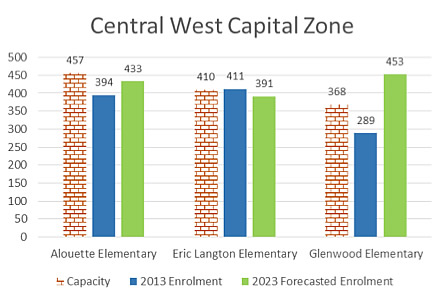
Eric Langton also has one portable classroom on-site to assist with enrolment and hosts the Early French Immersion Program for both the Central East and the East capital zones.
In the Central East Zone, the historical and forecasted enrolment is shown relative to the available functional capacity. By 2023 the elementary schools in this zone are expected to be fully utilized and additional space will be required to accommodate the forecasted enrolment.
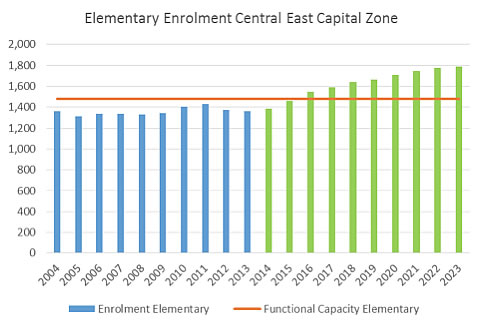
In the Central East Zone, there are also 3 elementary schools and the historical and forecasted enrolment is shown relative to the available functional capacity.
Golden Ears and Harry Hooge have 101 surplus spaces, even though Golden Ears hosts the School District’s Late French Immersion Program.
Yennadon has a utilization of 104% that in part reflects the enrolment demand from the Silver Valley area.
In the Central Capital Zone, the overall utilization of elementary schools is 92% and there are currently 218 surplus spaces.

Secondary Schools Central Capital Zone
In the Central Capital Zone, there are 2 secondary schools, one in each sub-zone – Maple Ridge Secondary in the Central West Zone and Thomas Haney Secondary in the Central East Zone. This zone also contains the secondary alternate programs at Maple Ridge Secondary Annex and South Lillooet.
In 2009, the repurposing of Mount Crescent Elementary to Maple Ridge Secondary Annex allowed the transfer of programs from Maple Ridge Secondary to the annex and the removal of portables from the Maple Ridge Secondary site. The annex is not utilized to full capacity by Maple Ridge Secondary.
The historical and forecasted enrolment is shown relative to the available functional capacity.
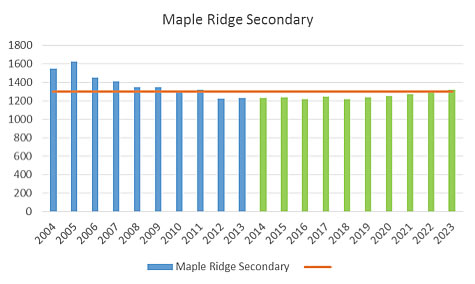

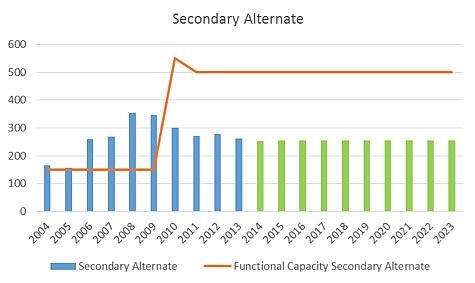
NOTE: Secondary alternate capacity was increased in 2010 with the conversion of Mount Crescent to MRSS annex and decreased in 2011 with the closure of Arthur Peak Centre.
When these schools are combined, the following graph demonstrates that there is some excess capacity in the zone at least until 2023.
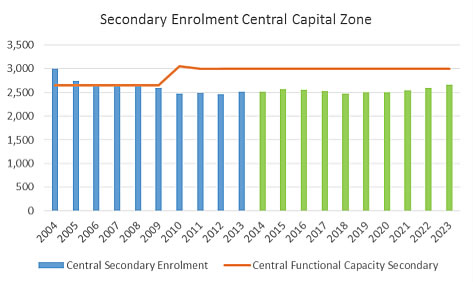
NOTE: Secondary capacity was increased in 2010 with the conversion of Mount Crescent to MRSS annex.
The capacity of the secondary schools and alternate secondary programs exceeds the enrolment in both zones. There is an overall utilization of 90% for the secondary schools and 55% for the secondary alternate programs.
Overall, in the Central Capital Zone, there are 251 surplus spaces in secondary and 223 in secondary alternate for 2013.


Planning Ahead Central Capital Zone
Maple Ridge is one of the BC communities experiencing relatively high growth. The table shows the historical population of Maple Ridge as reported by the Canada Census:

Maple Ridge continues to be a desirable location for youth and younger families where building lots are larger and housing is generally more affordable than other parts of Metro Vancouver. The 2004 Demographic Analysis and Population and Housing Projection for Maple Ridge, 2001-2031 prepared by The Sheltair Group and Kelly & Associates, projects Maple Ridge's population to be between 88,200 and 109,500 dependent on official community plan designation decisions made by District of Maple Ridge City Council.
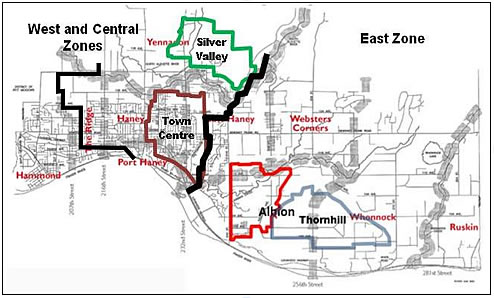
The District of Maple Ridge currently forecasts the growth trend will continue, but at a somewhat lower rate than previously predicted.
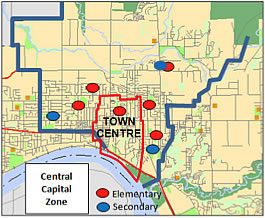
The majority of the current population is located in an east-west band within 5 kilometers north of the Fraser River. With agricultural and natural geographic boundaries restricting growth northward, the community continues to grow eastward along the Lougheed Corridor.
The BLACK lines show the area bounded by the Central Capital Zone. The key growth areas affecting this Zone are the Town Centre and Silver Valley areas.
In this Zone, growth is expected to be in the form of redevelopment in the Town Centre and infill in the Silver Valley area.
There are currently 218 surplus elementary spaces, 251 surplus secondary spaces and 223 secondary alternate spaces in this Zone.
The distribution of schools is generally well located to provide sufficient future spaces for growth in the Town Centre area, even though Eric Langton and Yennadon are currently full.
The challenge for the future will be to supply the additional capacity to accommodate growth from the Silver Valley area.
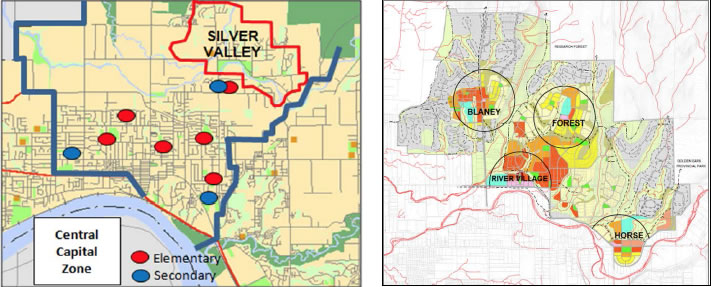
Currently there are 1,710 dwelling units within the Silver Valley planning area. The municipality estimates the total unit capacity for Silver Valley to be 3,700. As of November 2013, 842 units were under active development applications. The current elementary student population yield for the Silver Valley planning area is 0.29 elementary students per unit. If this yield is applied to the unit capacity of the area the estimated total number of elementary students in the area at build-out would be 1,073. Parents in this area can chose to enroll their children in the catchment area school or in any other school and may choose to enroll their children in a district program which is not offered in their catchment school.
The current elementary student yield from the Silver Valley Planning Area is 488 elementary students. In 2013, only 80% of the Silver Valley elementary students attended their catchment school – Yennadon Elementary. If the 80% participation was applied to the projected enrolment at build-out the estimated total number of elementary students to attend an in catchment school at build-out would be reduced to 858.
In order to accommodate all estimated elementary student enrolment from Silver Valley at build-out the school district will have to acquire and develop one school site in Silver Valley that would at a minimum accommodate a school with an operating capacity similar to that of Yennadon Elementary (545 students).
The current catchment for Yennadon Elementary includes areas that are not part of the Silver Valley Planning Area. As of September 30, 2013 the total in catchment students was 625, however only 66% enrolled at Yennadon. In the same year 140 out of catchment students were enrolled in Yennadon.
Silver Valley continues to develop and by 2023 an additional 313 elementary students are expected. This will place additional enrolment pressure on Yennadon as the closest elementary school.
If we allow some additional elementary growth from the Town Centre area as well, then it can be anticipated that all of the current excess capacity of 218 student spaces will be fully consumed and all elementary schools will approach 100% utilization before 2023.
Both MRSS Annex and South Lillooet are located in the Central Capital Zone and their combined utilization is only 55% with 223 available spaces in 2013. If the secondary alternate programs are relocated to facilities outside this capital zone these two facilities, with some renovation, could be converted to elementary schools.
The secondary schools are already at 90% utilization, with a current excess capacity of 251 student spaces. As the elementary enrolment increases, this will slowly translate to increases in secondary. 251 spaces should be sufficient to accommodate growth in the secondary grades in the Central Capital Zone through to 2023. Enrolment growth past this planning timeframe could be accommodated by increasing the capacity of the existing secondary schools in the area.
School Condition Central Capital Zone
There are many criteria used to evaluate a school and whether any or what investment should be made in the facility. Typical criteria are location, educational suitability, size and condition.
Some of these are subjective, but the key technical criteria are the overall facility condition, the seismic risk and building envelope condition. Explanations of these terms are included in the glossary of terms section of this report.
Both elementary and secondary schools in the Central Capital Zone and their FCI are as shown in the table. Schools with a FCI greater than 0.30 have a condition rating of “Poor”. Immediate attention to some significant building systems will be required.
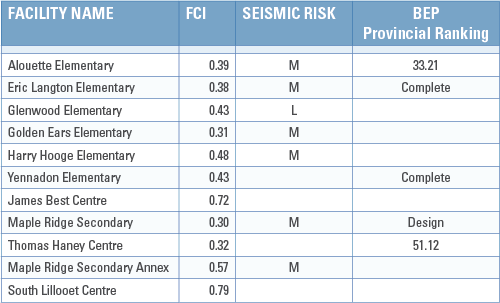
The seismic risk is a consolidated risk classification for the entire school. The school district has a complete list of the seismic status by individual school block. A classification of Medium (M) means that no significant structural mitigation is required. A classification of Low (L) means there is very little seismic risk in this school.
There are no schools in the Central Capital Zone with a current seismic classification that requires structural upgrading.
Most schools in the Central Capital Zone have been assessed for building envelope failures. They are shown in the table as well. The building envelope remediation projects for Alouette Elementary and Thomas Haney Secondary were included in previous school district capital plans.
Adding Classroom Capacity
It does not appear that additional classroom capacity must be acquired for schools in the Central Capital Zone. However, since the forecast indicates all elementary schools in this zone will reach 100% utilization by 2023, it is prudent to review where the possibilities are to expand capacity.
Of the elementary schools in the Central Zone, only Glenwood can accommodate a portable classroom or an addition of at least 4 classrooms. Both Eric Langton and Harry Hooge would have to place a portable or an addition on the current playfield, and even then the location is not desirable.
While Alouette may be able to accommodate a portable classroom on-site, neither Alouette, Golden Ears or Yennadon are able to accommodate a substantial addition given the current design of those schools and the land available.

